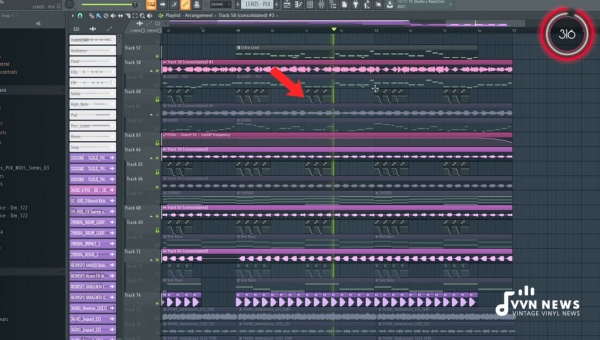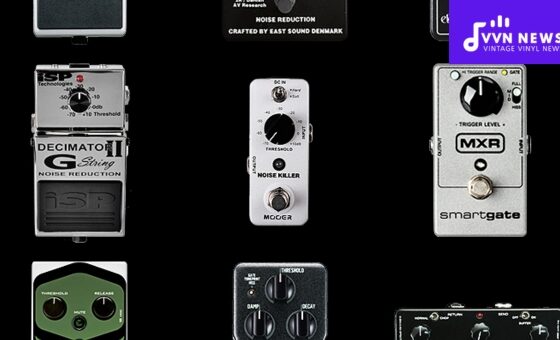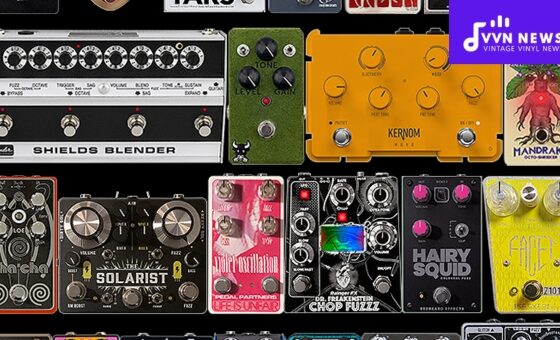Production is essential in the relentless quest for phenomenal sound and profound musicality. As a seasoned music creator, let me tell you — it’s not an easy task.
But isn’t it amazing how seeing the world from different perspectives can enrich our understanding?
And so it is with music production. In this realm, diverse insights can lead to innovations that progress our craft and cultivate our artistic voice.
With this in mind, I’ve curated a rich tapestry of 30 music production tips that will revamp your workflow and amplify your creative potential.
Every artist needs a palette of techniques, and these tips have been meticulously selected for their versatility and transformative power in shaping your musical productions.
The aim here is not merely to recite the textbook theories but to deliver practical solutions that can be immediately implemented.
These range from foundational skills and workflow management to nuanced production techniques that promise to level your output’s quality significantly.
Steer clear of any roadblocks on your creative voyage; embrace these 30 music production tips with open ears and an open mind.
30 Music Production Tips To Learn In 2025
Music production is an artistic pursuit as much as a technical one.
It’s not just about manipulating buttons and knobs; it’s a creative journey that requires astute attention to fine details and a relentless thirst for quality.
Let’s dive into the first two tips to guide you through this captivating odyssey.
Invest in Quality Studio Monitors
Creating music is like painting a picture, but instead of colors, you’re using sound waves.
Unfortunately, regular speakers can’t fully bring this vibrant sonic tableau to life. Therefore, I insist on the paramount importance of investing in quality studio monitors.
Why does this matter so much? Average home stereos and headphones are designed to make everything sound good.
They use specific equalization techniques that modify particular frequencies. Conversely, studio monitors offer an unaltered representation of your music; they don’t color or change the sound.
I cannot emphasize enough how crucial it is to perceive an accurate portrayal of your mixes while producing.
Keep in mind that when choosing studio monitors, it’s essential to consider your room size – larger rooms require more prominent speakers for accurately reproducing low frequencies.
Master Your DAW (Digital Audio Workstation)
Harnessing the full potential of your Digital Audio Workstation or DAW propels you miles ahead in the fiercely competitive world of music production.
It’s indispensable to know your chosen DAW like the back of your hand.
Each workspace offers its unique set of features and workflows. Familiarizing yourself with them will effectively make operations smoother and increase productivity significantly.
You might think jumping between different workstations makes you versatile, but mastering one holds more value than merely dabbling across multiple platforms.
As a beginner, you might want to experiment with various free trials before settling into one that fits your creative style best.
Excellent music production stems from understanding every nook and cranny of your workspace.
Also Read: 15 Best DAW In 2025 [Top Digital Audio Workstations]
Learn Music Theory
There’s no escaping it; understanding music theory is crucial to successful music production.
This knowledge forms the basis of all musical creations. It equips you with the tools to analyze and understand how different elements come together in a piece of music.
Music theory might seem daunting, but it all boils down to some basic principles: keys, scales, chords, rhythm, and melody.
Develop a foundational understanding of these concepts before moving on to more advanced topics like chord progressions or harmonies.
Initially, focus on learning major and minor scales as most melodies are based on these.
Also Read: Musical Modes Explained [What Are They & How Do I Use Them?]
Create a Comfortable and Ergonomic Workspace
Your workspace should inspire creativity and encourage productivity. Make sure your equipment is within easy reach and arrange everything in a way that makes sense to you – consider investing in a professional mixing desk for this purpose.
An ergonomic chair is another significant investment. Long hours hunched over your workstation can result in back pain if your chair doesn’t provide the proper support.
Also, to maintain healthy posture – keep your arms at 90° while working at your desk.
Lighting forms an integral part of the ambiance. Natural light is ideal for daytime work, while soft, warm lights help create cozy vibes during late-night sessions.
Lastly, ensure your workspace is clutter-free. A clean work area stimulates positivity and enhances mental clarity – critical aspects in every creative journey.
Develop Your Ear for Sound
As a music producer, having a keen ear for sound contributes massively to evaluating the quality of your productions.
Developing critical listening skills lets you identify nuances distinguishing great mixes from average ones.
Listening attentively to various genres can remarkably expand your audio palette – exposing you to different production styles and techniques.
And when you do, try to focus on specific elements: the bassline, the end of a reverb tail, or how the kick drum sounds.
Moreover, ear training exercises play a significant role in refining your listening skills. Engage with platforms like SoundGym’s daily training plan to help users improve their frequency detection skills, stereo perception, and more.
Prioritize these exercises regularly – your future productions will thank you for it!
Experiment with Different Instruments and Virtual Instruments
As a music producer, it’s pretty normal to have your favorite go-to instruments. Broadening your sonic palette and experimenting with different physical and virtual devices can be gratifying.
This process can free you from your routine, injecting a new perspective into your music.
Branching out and becoming proficient at various instruments enables a broader understanding of musical texture and dynamic range.
This exploration is not limited to traditional instruments; delve into the world of synthetic sound with virtual instruments or VSTs (Virtual Studio Technology).
Virtual instruments open a whole new universe of sounds right at your fingertips, allowing you to create unique sonic landscapes that defy the limitations of physical reality.
Many DAWs come equipped with robust VST libraries; an extensive collection of third-party plugins is available online.
Websites like Native Instruments, KV331 Audio, and Spitfire Audio offer a variety of premium VSTs for every imaginable genre.
Learn to manipulate these tools expertly – tweak oscillators in synths, vary string tensions in piano VSTs, or adjust timpani’s skin tension in orchestral plugins for personalized soundscapes.
Also Read: Instrument Miking Techniques To Capture The Best Sound 2025
Focus on Arrangement and Song Structure
Great arranging is an underappreciated art, often taking a back seat amidst riffs, melodies, and beats.
A well-arranged song builds emotion effectively and keeps the listener hooked throughout its duration.
The structure is the backbone of any composition – the roadmap guides how each section unravels.
A typical song structure follows the pattern: Intro -> Verse -> Chorus -> Verse -> Chorus -> Bridge (optional) -> Chorus -> Outro.
While this template is an excellent starting point for traditional pop songs, don’t be afraid to explore unconventional layouts that better fit your unique musical narrative.
Remember that each segment shapes the overall journey; spacing and transitions are vital.
Use tones, fundamental changes, dynamic contrasts, or tempo shifts to spice up section transitions.
Use Reference Tracks for Mixing and Mastering
Mixing and mastering are essentially shaping the track’s final sound. They are equal parts art and science, requiring musical intuition and technical know-how.
A handy tool in this process is a professionally mixed and mastered reference track that aligns with your vision.
It’s a standard against which you balance frequencies, compare dynamics & stereo width, maintain levels, etc., facilitating critical listening.
Audition in multiple environments before settling on a reference; test how it sounds in your studio, car stereo, headphones, etc.
This will give you a clearer perception of the track’s sonic spectrum.
Good resources for high-quality reference tracks include WAVs purchased from Beatport or CDs due to their uncompressed nature. Streaming platforms may not be ideal due to potential audio quality reduction from data compression algorithms.
Do not to mimic your reference exactly but use it as a guide when making critical decisions during your mixing process.
Embracing these tips can have a profound impact on your music production journey.
A broad palette of instruments offers flexibility; bright arrangement provides fluidity; using references ensures your mix resonates professionally across varied listening contexts.
Pay Attention to Gain Staging
When we talk about gain staging, we refer to managing the volumes of multiple signals throughout your mix.
Prioritizing gain staging can be a game-changer in producing clarity and avoiding distortion in your tracks.
When setting up gain stages, start configuring the input level on your audio interface before moving onto individual track levels in your DAW.
Make sure your recording signals aren’t clipping and maintain adequate headroom. Aim for an average level around -18dBFS and a peak no higher than -10dBFS.
Understanding gain structure is crucial for achieving the perfect balance between loudness, clarity, and dynamics in musical production. So, start low, keep an eye on the meters, and keep your ears open.
Practice Sound Design
Sound design is creating soundscapes or sonic textures that enhance a piece of music’s emotional impact.
Embracing this skill offers unlimited creative possibilities in creating unique sounds that add character to your music.
A vast array of tools are available for sound design: synthesizers (both analog and digital), samplers, effect plugins such as reverbs or distortions, and field recording equipment for capturing organic sounds.
Sound design isn’t about mastering every tool available – it’s about exploring outside comfort zones and experimenting with various techniques.
Therefore, dive deep into sampling different musical instruments or environmental sounds, manipulating audio signals through various effects processors.
Collaborate with Other Musicians & Producers
Collaborations are what make the musical world go round! Teaming up with other musicians & producers sparks creativity through new perspectives and ideas that may not have occurred individually.
You can learn numerous different creative processes from others. Plus, it’s an excellent opportunity to expand your network of artists with whom you might want to work with regularly!
Reliable platforms for finding kit collaborations include SoundCloud, Bandcamp, Kompoz, and Blend.io. Connect with artists whose music resonates with you, and never underestimate the power of collaboration.
Learn to Play a Musical Instrument
Playing a musical instrument drastically changes how you understand and perceive music.
It builds an intimate connection with pitches, chords, melodies, and rhythms that can’t be replicated in other ways.
Understanding even a single instrument can lead to improved compositional skills.
Whether drums for rhythm, keyboards for harmony, or guitar for melody – every tool adds different dimensions to production.
Conclusively, producing music isn’t just about sophisticated software or flashy plugins. At its core, it’s about developing an aesthetic sensibility towards sound.
Therefore, as producers, we should strive not only to produce a good mix but also be able to create our unique sonic identity through constant learning and practicing.
Understanding the Importance of EQ
No tool is as powerful and versatile as Equalization (EQ) when shaping your sound. It regulates frequencies for creating a balanced and harmonized mix within your music production.
Consider EQ as an adjustable filter that amplifies or attenuates specific frequency ranges, allowing you to highlight or suppress particular elements in the mix.
The key here is to understand that every sound, from raw vocals to blistering guitar solos, exists within a unique range of frequencies.
You can sculpt these frequency regions through EQ control to craft a more cohesive sound panorama pleasing to the listener.
Also Read: Guide To Applying EQ Cheat Sheet On Various Instruments 2025
Here are the basics:
- Low Frequencies (20Hz – 250Hz). This area controls elements like the kick drum, the low end of the bass, and the rumble.
- Mid-Low Frequencies (250Hz – 2kHz). This band manages instruments like guitars and vocals.
- Mid-High Frequencies (2kHz – 8kHz). Holding clarity and presence; handles both vocals and main instruments.
- High Frequencies (8kHz upwards). Often called “air,” it gives brightness to your mix.
Using Compression Effectively
Compression is another pivotal tool for music producers. Simply put, it controls dynamic range—the difference between an audio signal’s loudest and quietest parts.
Adjusting these extremes with compression effectively ensures all parts are well audible without overpowering elements in your track.
Compressor parameters include Threshold (the level where compression starts), Ratio (degree of reduction), Attack (how quickly the compressor starts), Release (how fast it stops after the signal falls below the threshold), and Make-up Gain (adjust the output level post-compression).
Working on Your Timing and Rhythm
In music production, timing isn’t just essential—it’s everything! Solid rhythm forms the backbone of any track.
Products like a Metronome can help maintain consistent beats while recording instruments or vocals, significantly reducing the workload during the post-production phase.
If your timing falls off, rhythmic editing tools such as ‘Quantize’ in DAWs help align notes correctly.
Automating Parameters for Dynamic Mixes
Automation breathes life into music by adding moment-to-moment changes across various mix parameters, such as volume, panning, plug-in controls, etc. Without automation, a song may sound static and lifeless.
This feature allows you to create a detailed roadmap for these parameters’ movements throughout the track, meaning you automatically automate them to change over time.
Embrace automation to enhance elements of surprise in your tracks and keep listeners on their toes.
Automation helps produce a sense of growth and natural evolution in your tracks that hooks listeners from start to finish.
Don’t Overdo It with Effects
While effects can certainly enhance the sound and bring polish to your track, it’s crucial not to overdo it.
The goal is to complement the harmony, dynamics, and rhythm — not mask them behind a wall of reverb, delay, or distortion.
Effects should be used to add depth and character or fix minor recording flaws. What sets you apart is not how many effects you use but how thoughtfully you use them.
A valuable tip here would be to use Subtractive EQ: rather than adding frequencies with equalization (EQ), try removing the ones that are not needed. This technique often results in a cleaner mix.
Keep Your Sessions Organized
An underrated but profoundly significant aspect of music production is organization.
It makes your workflow smoother and massively helps when revisiting older projects or collaborating with other artists – imagine spending hours scouring through hundreds of unnamed tracks.
Organizing your sessions entails correctly naming and coloring coding tracks systematically, grouping similar sounds like drums, vocals, and strings, deleting unused tracks, and keeping backups of sessions diligently.
One feature I find incredibly useful is the ‘save as’ function in many DAWs. It allows you to keep different versions of sessions as your song progresses – enabling more room for exploration and ideas without fear of losing previous versions.
Learn About Different Audio File Formats And Bit Rates
Every format has its advantage – understanding what to use when can significantly impact the quality of your production.
There are two sorts: lossless formats like WAV and AIFF, which give high-quality output but consume considerable storage space; then you have lossy formats such as MP3 and AAC, which economically use space but at the cost of quality.
Producers generally work with WAV or AIFF during production for maximum fidelity.
The final distribution often happens in MP3 or AAC due to their compatibility with music players and streaming platforms.
Similarly, with bit rates, higher rates like 24-bit or 32-bit floating-point offer unparalleled quality but require more storage – best for recording. On the other hand, 16-bit is the industry standard for final distribution.
Take Breaks to Prevent Ear Fatigue
Making music can be so fascinating- losing track of time is easy. Continuous exposure to sound can lead to ear fatigue.
Symptoms include tiredness, discomfort, and even temporary hearing loss in severe cases.
To avoid this, take a break every hour – This rest period is suitable for your ears and helps maintain objectivity while mixing – a clean mind can make accurate adjustments.
Monitor music at low volumes – protect your precious hearing; without it, there’s no music!
All these tips may seem daunting at first glance – mainly if you are new to this world!
Experiment with Microphone Placement and Techniques
As with any artistic tool, knowing how to use a microphone to its full potential is critical.
Microphone placement and recording techniques can significantly influence the impact of your recordings.
For instance, the proximity effect occurs when you bring the microphone close to your source, making the low frequencies more pronounced.
If you’re looking for a bigger sound that occupies more space in your mix, experiment with different mic placements.
Try placing it directly in front or at an angle from the source and note the nuances each placement brings out.
There’s a goldmine of varied tonal qualities you wouldn’t experience otherwise!
Similarly, understanding different polar patterns (Cardioid, Omnidirectional, Figure-8) enhances recording variety and versatility.
A Cardioid pattern picks up sound predominantly from the front and is often used for a single sound source, while an Omnidirectional pattern captures sounds equally from all directions.
Experimenting allows you to find the best combinations for various scenarios.
Also Read: 25 Fundamental Audio Mixing Tips & Techniques of 2025
Utilize Bussing And Routing For Efficiency
Bussing refers to directing multiple track outputs into a single track or ‘bus.’ It’s like grouping similar items – say drums or vocals- in one package so they can be processed as one unit.
Well, bussing makes mixing quicker and simplifies the automation process of whole sections instead of individual tracks.
Routing links different signal path parts, allowing flexibility and creative functioning within your DAW. Learn how to create Auxiliary sends & return paths for reverbs or delays, which is more CPU efficient.
1) Pre-Fader auxiliary sends allow effects levels unaffected by changing the original track’s volume.
2) Post-Fader auxiliary sends keep effect level proportionate to changes made in track volume.
Use High-quality Audio Interfaces And Preamps
Why do you need a high-quality interface or preamp? Think of it like differentiating between freshly pressed and canned juice — while both serve the same purpose, one is far superior in taste and nutritional value!
This does not mean spending ludicrous money but getting something that’s a perfect fit for your setup.
The clarity, transparency, and definition that an audio interface brings to your sound can drastically change how your recording sounds.
A preamplifier boosts the low-level signal from your mic to a line signal for further processing.
A good preamp eliminates noise interference, retaining only pure sound from instruments/vocals.
Master The Art Of Vocal Recording And Editing
Now, onto my favorite- vocal recording! Creating an intimate setting conducive to the singer is critical. Please make sure they are comfortable with headphone settings & mic placement.
Get familiar with features like ‘comping,’ where you can take parts of different takes to create a ‘perfect’ take.
Harness pitch correction tools sparingly — the authenticity of a voice often lies in its imperfections!
Finally, learn how to edit breaths, tune out unwanted pops and clicks, and effectively use standard de-using techniques to treat harsh sibilance issues.
The world of music production is vast! But armed with these insights, you’re well on the path to creating sonic landscapes that resonate profoundly and enrich lives.
Explore Various MIDI Controllers
The beauty of MIDI (Musical Instrument Digital Interface) controllers is how they bring software instruments to life, making them as tactile and responsive as their physical counterparts.
They provide a hands-on approach, facilitating a more interactive music production experience.
Nowadays, there are different types of MIDI controllers on the market – from traditional keyboards to drum pads, DJ control surfaces, wind controllers, and even modern, innovative touchscreen designs.
Some popular choices among producers include products like the Akai MPK Mini, Native Instruments Maschine, and Ableton Push.
Each of these offers unique features that suit distinct production styles. Hence, sampling varied models will expose you to different workflows and spark creativity in unimaginable ways.
Develop a Signature Sound or Style
Developing your unique sound or style is arguably one of the most crucial aspects of being a musician. It’s what sets you apart from everyone else in this saturated industry.
Begin by trying out different genres. Once you’ve explored enough territory, pinpoint what resonates with you the most—focus on refining this into your signature sound.
The trick here is persistence; your style might not emerge overnight but will evolve gradually through practice and experimentation.
Study The Music Production Process Of Your Favorite Artists
I’ve found studying and analyzing tracks produced by my favorite artists incredibly beneficial. Listening closely to their music can reveal a fountain of techniques waiting to be discovered!
By dissecting their production – rhythm patterns, melody progressions, EQ settings – you’re essentially ‘standing on the shoulders of giants’ as you embed these secrets into your works.
Famous producer Rick Rubin once said: “The artist who becomes successful is the one who learns how to take their unique viewpoint and translate it into something others can relate to.”
Let your idols’ production wizardry become catalysts to fuel your artistic growth.
Stay Updated With Industry Trends and Technology
Finally, never underestimate the importance of staying current with the industry’s latest trends and technologies.
In this fast-paced digital age, tech advancements constantly push the boundaries in music production.
New plugins, sample libraries, breakthroughs in AI-powered software – it’s essential to stay updated with these trends.
Subscribing to relevant newsletters or joining online communities such as Gearslutz or KVR Audio will keep you well-informed about the latest developments.
Growth and learning in music production is a constant adventure that frequently takes unsuspected yet gratifying turns.
Understand the Importance of Balance in Mixing
Learning the importance of balance in mixing is a pivotal lesson on your journey to becoming a seasoned music producer.
Even the most compelling composition risks becoming cluttered and discordant without a well-balanced mix.
First, let’s clarify what balance means – it signifies the delicate interplay between different elements of your mix (like vocals, drums, and various instruments) concerning their relative volume levels and frequency range.
Bass vs. Treble, Vocals vs. Backing Vocals, Drums vs. Percussions — achieving equilibrium between all these elements ensures that every part contributes to the overall sound without overcrowding it or making it feel sparse.
- Equalization is crucial in shaping and enhancing individual instrument tones so they have their defined space in your mix.
- Compression can reduce dynamic range variations, bringing balance to quieter and louder parts of a song.
- Automation could refine balance dynamically throughout the song based on intensity and emotion.
Maintaining balance doesn’t mean keeping everything at equal volume but designing each element’s level to serve the entire composition’s emotional intent.
Trust Your Instincts and Be Open to Creative Risks
One priceless aspect you should cultivate as a music producer is trusting your instincts while being courageous enough to take creative risks.
Rules in music are there as guides rather than laws etched in stone.
Imagine if The Beatles hadn’t dared with psychedelic sounds or if Skrillex hadn’t explored aggressive bass drops!
They were guided by knowledge, skill, and intuition — that big ‘what if’ pushing boundaries beyond conventional patterns.
While learning from trends can be helpful, not shying away from out-of-the-box ideas testifies to authentic creativity.
It could lead to an innovative musical output that sets you apart.
In essence, trust the voice within. That peculiar chord progression or that unconventional drum pattern making your heart flutter?
It could lead to a breakthrough in your signature style, establishing your unique mark in the music realm.
FAQs About Music Production Tips
What is the significance of investing in quality studio monitors?
Studio monitors precisely represent your music without altering particular frequencies, allowing you to create a more accurate mix.
Why should I master one DAW instead of learning multiple?
By mastering one DAW, you can harness its full potential, streamline your workflow, increase productivity and create high-quality music more efficiently.
Can I use regular speakers for music production?
While you can use regular speakers for casual listening, they modify specific frequencies and fail to represent your mix accurately. Hence, studio monitors are preferable.
What is the benefit of learning music theory in production?
Music theory equips you with a better understanding and flexibility when analyzing and composing melodies or harmonies. It gives you a solid foundation to build upon your unique style.
How important is collaboration as a music producer?
Collaboration can be highly beneficial as it offers fresh insights, shares different techniques, and expands your perspective on creating music.
Conclusion
Producing music is both an art and a science demanding a well-rounded approach.
These 30 Music Production Tips are a broad guide catering to diverse production demands. Let them steer your creative process.
Learning never stops in the world of music production. Every day brings with it breakthroughs and ways to refine your craft.
Drive yourself through the allure of understanding sound at its most elemental level, and relish in the joyous adventure of making noise into harmony.
Continue creating, continue exploring, and above all, continue enjoying your musical journey!








